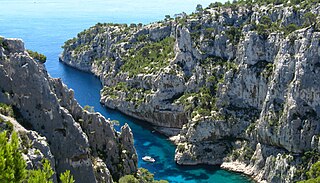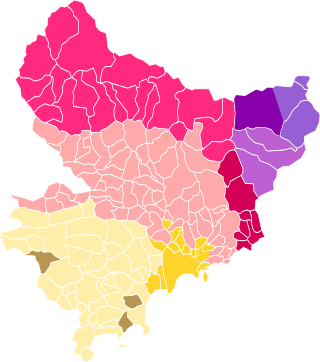Languedoc is a former province of France.
Languedoc may also refer to:
Languedoc is a former province of France.
Languedoc may also refer to:
Languedoc -The modern day equivalent to Stradivarius but for guitars. See Paul Languedoc et all.

Occitan, also known as lenga d'òc by its native speakers, and sometimes also referred to as Provençal, is a Romance language spoken in Southern France, Monaco, Italy's Occitan Valleys, as well as Spain's Val d'Aran in Catalonia; collectively, these regions are sometimes referred to as Occitania. It is also spoken in Calabria in a linguistic enclave of Cosenza area. Some include Catalan in Occitan, as the distance between this language and some Occitan dialects is similar to the distance between different Occitan dialects. Catalan was considered a dialect of Occitan until the end of the 19th century and still today remains its closest relative.

The Province of Languedoc is a former province of France. Most of its territory is now contained in the modern-day region of Occitanie in Southern France. Its capital city was Toulouse. It had an area of approximately 42,700 square kilometers.

Languedoc-Roussillon is a former administrative region of France. On 1 January 2016, it joined with the region of Midi-Pyrénées to become Occitania. It comprised five departments, and bordered the other French regions of Provence-Alpes-Côte d'Azur, Rhône-Alpes, Auvergne, Midi-Pyrénées towards the north, and Spain, Andorra and the Mediterranean Sea towards the south. It was the southernmost region of mainland France.

Midi-Pyrénées is a former administrative region of France. Since 1 January 2016, it has been part of the new region of Occitania. It was the largest region of Metropolitan France by area, larger than the Netherlands or Denmark.

Languedocien, Languedocian, or Lengadocian is an Occitan dialect spoken in rural parts of southern France such as Languedoc, Rouergue, Quercy, Agenais and Southern Périgord. It is sometimes also called Languedocien-Guyennais. Due to its central position among the dialects of Occitan, it is often used as a basis for a Standard Occitan.

The langues d'oïl are a dialect continuum that includes standard French and its closest autochthonous relatives historically spoken in the northern half of France, southern Belgium, and the Channel Islands. They belong to the larger category of Gallo-Romance languages, which also include the historical languages of east-central France and western Switzerland, southern France, portions of northern Italy, the Val d'Aran in Spain, and under certain acceptations those of Catalonia.

Southern France, also known as the south of France or colloquially in French as le Midi, is a defined geographical area consisting of the regions of France that border the Atlantic Ocean south of the Marais Poitevin, Spain, the Mediterranean Sea and Italy. It includes southern Nouvelle-Aquitaine in the west, Occitanie in the centre, the southern parts of Auvergne-Rhône-Alpes in the northeast, Provence-Alpes-Côte d'Azur in the southeast, as well as the island of Corsica in the southeast. Southern France is generally included into southern Europe because of its association with the Mediterranean Sea.

Occitania is the historical region in Western and Southern Europe where the Occitan language was historically spoken and where it is occasionally used as a second language. This cultural area roughly encompasses much of the southern third of France as well as part of Spain, Monaco, and parts of Italy.
Roussillon is one of the historical counties of the former Principality of Catalonia, corresponding roughly to the present-day southern French département of Pyrénées-Orientales save Fenouillèdes.

Vin de pays was a French wine classification that was above the vin de table classification, but below the appellation d'origine contrôlée (AOC) classification and below the former vin délimité de qualité supérieure classification. The vin de pays classification was replaced by the EU indication Indication Géographique Protégée in 2009.

Niçard, nissart/Niçart, niçois, or nizzardo is the dialect that was historically spoken in the city of Nice, in France, and in a few surrounding communes. Niçard is a subdialect of Provençal, itself a dialect of Occitan. Some Italian irredentists have claimed it as a Ligurian dialect, on false grounds.

Languedoc-Roussillon wine, including the vin de pays labeled Vin de Pays d'Oc, is produced in southern France. While "Languedoc" can refer to a specific historic region of France and Northern Catalonia, usage since the 20th century has primarily referred to the northern part of the Languedoc-Roussillon region of France, an area which spans the Mediterranean coastline from the French border with Spain to the region of Provence. The area has around 700,000 acres (2,800 km2) under vines and is the single biggest wine-producing region in the world, being responsible for more than a third of France's total wine production. In 2001, the region produced more wine than the United States.

Cabardès is an Appellation d'Origine Contrôlée (AOC) for red and rosé wine in Languedoc-Roussillon wine region in France. Cabardès was named after the Lords of Cabaret who defended the Châteaux de Lastours against Simon de Montfort in 1209. Despite the name's medieval origins, this appellation is one of the youngest in France, having only become official in February 1999.
In Occitan, vergonha refers to the effects of various language discriminatory policies of the government of France on its minorities whose native language was deemed a patois, where a Romance language spoken in the country other than Standard French, such as Occitan or the langues d'oïl, as well as other non-Romance languages such as Alsatian and Basque, were suppressed. Vergonha is imagined as a process of "being made to reject and feel ashamed of one's mother tongue through official exclusion, humiliation at school and rejection from the media", as organized and sanctioned by French political leaders from Henri Grégoire onward.

The Croissant is a linguistic transitional zone between the Langue d'oc dialects and the Langue d'oïl dialects, situated in the centre of France where Occitan dialects are spoken that have transitional traits toward French. The name derives from the contours of the zone that resemble a croissant, or crescent.
Provençal may refer to:

Occitania is the southernmost administrative region of metropolitan France excluding Corsica, created on 1 January 2016 from the former regions of Languedoc-Roussillon and Midi-Pyrénées. The Council of State approved Occitania as the new name of the region on 28 September 2016, coming into effect on 30 September 2016.

The Partit Nacionalista Occitan, more simply, "PNO" is a political party of Occitania, founded in 1959 by François Fontan (1929–1979). The current name is "Partit de la Nacion Occitana".

The Revolt of the Languedoc winegrowers was a mass movement in 1907 in Languedoc and the Pyrénées-Orientales of France that was repressed by the government of Georges Clemenceau. It was caused by a serious crisis in winemaking at the start of the 20th century. The movement was also called the "paupers revolt" of the Midi. It was marked by the fraternization of the 17th line infantry regiment with the demonstrators in Béziers.

The French Great South-West is a geographical, sociological, economic and cultural entity bringing together the administrative regions of Nouvelle-Aquitaine and Occitanie, resulting from the merger on January 1, 2016, of five previous regions; in these two regions combined, it covers 156,000 km2, or 29% of the territory of metropolitan France. It is a grouping devoid of its own political or administrative structures, set up, with the objective of an interregional reflection on spatial planning at the level of new European issues, at the initiative of the Interministerial Delegation at territory planning and regional attractiveness.